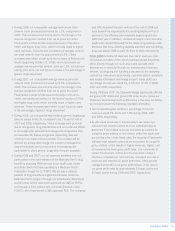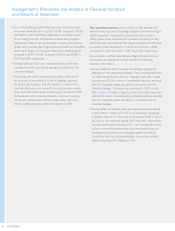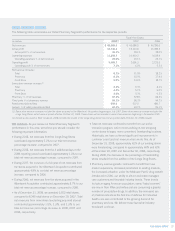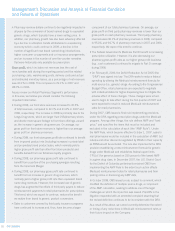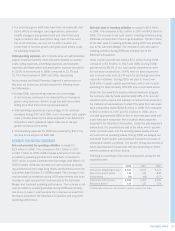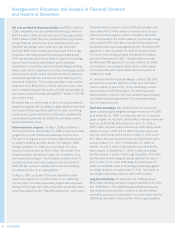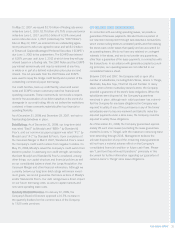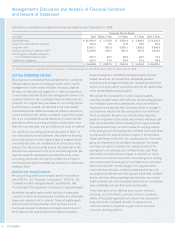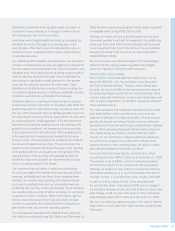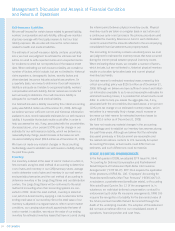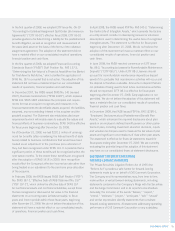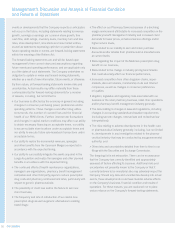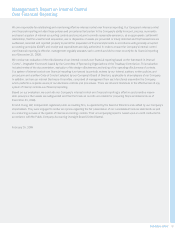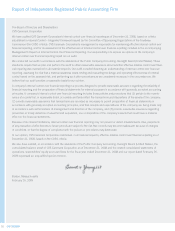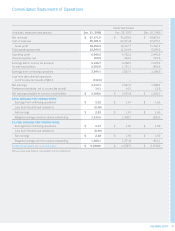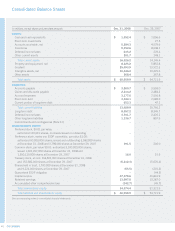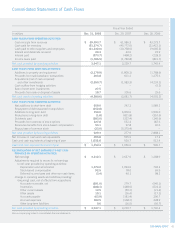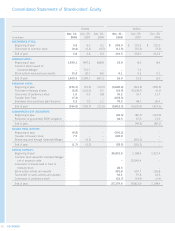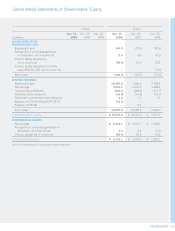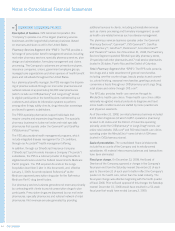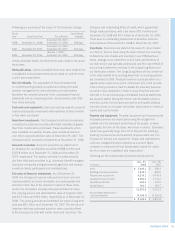CVS 2008 Annual Report Download - page 39
Download and view the complete annual report
Please find page 39 of the 2008 CVS annual report below. You can navigate through the pages in the report by either clicking on the pages listed below, or by using the keyword search tool below to find specific information within the annual report.
2008 ANNUAL REPORT 35
In the fi rst quarter of 2008, we adopted EITF Issue No. 06-10
“Accounting for Collateral Assignment Split-Dollar Life Insurance
Agreements” (“EITF 06-10”) effective fi scal 2008. EITF 06-10
provides guidance for determining a liability for the postretirement
benefi t obligation, as well as recognition and measurement of
the associated asset on the basis of the terms of the collateral
assignment agreement. The adoption of this statement did not
have a material effect on our consolidated results of operations,
fi nancial position and cash fl ows.
In the fi rst quarter of 2008, we adopted Financial Accounting
Standards Board (“FASB”) Staff Position No. FAS 157-3,
“Determining the Fair Value of a Financial Asset When the Market
for That Asset Is Not Active,” which clarifi es the application of
SFAS No. 157 in a market that is not active. The adoption of this
statement did not have a material impact on our consolidated
results of operations, fi nancial position and cash fl ows.
In December 2007, the FASB issued SFAS No. 141 (revised
2007), Business Combinations (“SFAS 141R”), which replaces
SFAS 141. SFAS 141R establishes the principles and require-
ments for how an acquirer recognizes and measures in its
fi nancial statements the identifi able assets acquired, the liabilities
assumed, any noncontrolling interest in the acquiree and the
goodwill acquired. The Statement also establishes disclosure
requirements which will enable users to evaluate the nature and
fi nancial effects of business combinations. SFAS 141R is effective
for fi scal years beginning after December 15, 2008.
As of December 31, 2008, we had $202.3 million of unrecog-
nized tax benefi ts (after considering the federal benefi t of state
taxes) related to business combinations that would have been
treated as an adjustment to the purchase price allocation if
they had been recognized under SFAS 141. It is possible that a
signifi cant portion of these benefi ts will be recognized within the
next twelve months. To the extent these benefi ts are recognized
after the adoption of SFAS 141R in 2009, their recognition
would affect the Company’s effective income tax rate rather than
being treated as an adjustment to the purchase price allocation
of the acquiree.
In February 2008, the FASB issued FASB Staff Position (“FSP”)
No. SFAS 157-2, “Effective Date of FASB Statement No. 157”
(“FSP 157-2”), which defers the effective date of SFAS 157
for nonfi nancial assets and nonfi nancial liabilities, except those
that are recognized or disclosed at fair value in the fi nancial
statements on a recurring basis (at least annually), to fi scal
years and interim periods within those fi scal years, beginning
after November 15, 2008. We do not believe the adoption of this
statement will have a material effect on our consolidated results
of operations, fi nancial position and cash fl ows.
In April 2008, the FASB issued FSP No. FAS 142-3, “Determining
the Useful Life of Intangible Assets,” which amends the factors
an entity should consider in developing renewal or extension
assumptions used in determining the useful lives of recognized
intangible assets. This statement is effective for fi scal years
beginning after December 15, 2008. We do not believe the
adoption of this statement will have a material effect on our
consolidated results of operations, fi nancial position and
cash fl ows.
In June 2008, the FASB reached consensus on EITF Issue
No. 08-3, “Accounting by Lessees for Nonrefundable Maintenance
Deposits” (“EITF 08-3”). Under EITF 08-3, lessees should
account for nonrefundable maintenance deposits as deposit
assets if it is probable that maintenance activities will occur and
the deposit is therefore realizable. Amounts on deposit that are
not probable of being used to fund future maintenance activities
should be expensed. EITF 08-3 is effective for fi scal years
beginning after December 15, 2008. Early application is not
permitted. We do not believe the adoption of this statement will
have a material effect on our consolidated results of operations,
fi nancial position and cash fl ows.
In December 2008, the FASB issued FSP No. FAS 132(R)-1,
“Employers’ Disclosures about Postretirement Benefi t Plan
Assets,” which enhances the required disclosures about plan
assets in an employer’s defi ned benefi t pension or other postre-
tirement plan, including investment allocation decisions, inputs
and valuation techniques used to measure the fair value of plan
assets and signifi cant concentrations of risks within plan assets.
This statement is effective for fi nancial statements issued for
fi scal years ending after December 15, 2009. We are currently
evaluating the potential impact the adoption of this statement
may have on our consolidated fi nancial statement disclosures.
CAUTIONARY STATEMENT CONCERNING
FORWARD-LOOKING STATEMENTS
The Private Securities Litigation Reform Act of 1995 (the
“Reform Act”) provides a safe harbor for forward-looking
statements made by or on behalf of CVS Caremark Corporation.
The Company and its representatives may, from time to time,
make written or verbal forward-looking statements, including
statements contained in the Company’s fi lings with the Securities
and Exchange Commission and in its reports to stockholders.
Generally, the inclusion of the words “believe,” “expect,”
“intend,” “estimate,” “project,” “anticipate,” “will,” “should”
and similar expressions identify statements that constitute
forward-looking statements. All statements addressing operating
performance of CVS Caremark Corporation or any subsidiary,


